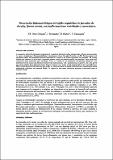Por favor, use este identificador para citar o enlazar a este item:
http://hdl.handle.net/10261/104146COMPARTIR / EXPORTAR:
 SHARE
BASE SHARE
BASE
|
|
| Visualizar otros formatos: MARC | Dublin Core | RDF | ORE | MODS | METS | DIDL | DATACITE | |

| Campo DC | Valor | Lengua/Idioma |
|---|---|---|
| dc.contributor.author | Ortiz-Delgado, Juan B. | - |
| dc.contributor.author | Fernández, Ignacio | - |
| dc.contributor.author | Gisbert, Enric | - |
| dc.contributor.author | Sarasquete, Carmen | - |
| dc.date.accessioned | 2014-10-31T11:49:26Z | - |
| dc.date.available | 2014-10-31T11:49:26Z | - |
| dc.date.issued | 2011-11 | - |
| dc.identifier.citation | XIII Congreso Nacional de Acuicultura (2011) | - |
| dc.identifier.uri | http://hdl.handle.net/10261/104146 | - |
| dc.description | Trabajo presentado en el XIII Congreso Nacional de Acuicultura, celebrado en Barcelona del 21 al 24 de noviembre de 2011. | - |
| dc.description.abstract | A comparative study of the histological morphology of normal and deformed vertebrae and operculum of Sparus aurata juveniles by means of histological (Haematoxylin/Eosin), hist ochemical (Alcian blue-AB, Picrosirius red–PR, Tart rate-resistant acid phosphatase-TRAP) and inmunohistochemical (Osteocal cin-Oc, Caspase-3 and PCNA) approaches was performe d. PR staining showed some differences in bone matrix composition between normal and deformed vertebra and operculum. These results were corroborated under polarization optic microscope. P CNA as a marker of cell proliferation also presente d differences in its distribution between normal and deformed vertebral bodies and operculum, with a marked increase in pos itive cells in the growth zone of the endplates from deformed vertebra. Howev er, Caspase-3 as a marker of cell apoptosis did not show such differences. TRAP activity detected in trabecular bone from heal thy sea bream specimens was lacked in deformed ones , suggesting that normal endochondral ossification was restrained. Finally, Oc changed its bone matrix distribution appearing i n notochordal tissue of deformed vertebra. | - |
| dc.description.sponsorship | Este trabajo fue financiado por el MICINN (proyectos AGL2008-03897-C04-04 y AGL2010-15951) y el CSIC (PIF-200930I128). | - |
| dc.rights | openAccess | - |
| dc.title | Descripción histomorfológica del tejido esquelético de juveniles de dorada, Sparus aurata, con malformaciones vertebrales y operculares | - |
| dc.type | póster de congreso | - |
| dc.date.updated | 2014-10-31T11:49:26Z | - |
| dc.description.version | Peer Reviewed | - |
| dc.language.rfc3066 | spa | - |
| dc.contributor.funder | Consejo Superior de Investigaciones Científicas (España) | - |
| dc.contributor.funder | Ministerio de Ciencia e Innovación (España) | - |
| dc.identifier.funder | http://dx.doi.org/10.13039/501100003339 | es_ES |
| dc.identifier.funder | http://dx.doi.org/10.13039/501100004837 | es_ES |
| dc.type.coar | http://purl.org/coar/resource_type/c_6670 | es_ES |
| item.openairecristype | http://purl.org/coar/resource_type/c_18cf | - |
| item.fulltext | With Fulltext | - |
| item.cerifentitytype | Publications | - |
| item.openairetype | póster de congreso | - |
| item.grantfulltext | open | - |
| Aparece en las colecciones: | (ICMAN) Comunicaciones congresos | |
Ficheros en este ítem:
| Fichero | Descripción | Tamaño | Formato | |
|---|---|---|---|---|
| histomorfologica_tejido_Ortiz.pdf | 64,78 kB | Adobe PDF |  Visualizar/Abrir |
CORE Recommender
Page view(s)
260
checked on 18-abr-2024
Download(s)
104
checked on 18-abr-2024
Google ScholarTM
Check
NOTA: Los ítems de Digital.CSIC están protegidos por copyright, con todos los derechos reservados, a menos que se indique lo contrario.
